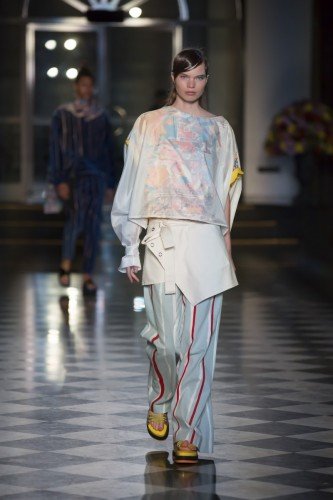Waste Textile Sourcing
Waste Textile Sourcing
Created by Redress

What is It?
Sourcing ‘waste’ textile is a critical strategy to ensure circularity in fashion. By revaluing textile resources that would have otherwise ended up landfilled or burned, product creators have the opportunity to bring new life to old stock, avoiding the creation of virgin materials and unnecessary depletion of natural resources.
At Redress we differentiate between types of waste textiles:
- Textile waste: textile swatches, cut-and-sew textiles, end-of-rolls, sampling yardage, damaged textiles, unsold clothing, clothing samples, secondhand clothing, secondhand textiles.
- Textile created from waste: textile made from regenerated fibres, including recycled cotton, recycled wool, food industry by-products, or reclaimed plastic.
TEXTILE WASTE
Textile waste is the textile by-product of the manufacturing of garments, fabrics, yarns, or fibres that are deemed unusable for its original purpose.
Textile waste can include fashion and textile industry waste, created during the production of fibres, textiles, and clothing; and consumer waste, created during consumer use and disposal.
PRE-CONSUMER textile waste is manufacturing waste that has not reached the consumer.

Textile swatches are leftover textile sample swatches from the production process.

Cut-and-sew waste are textile scraps generated during garment manufacturing. They are often discarded due to their uneven and small shapes.

End-of-rolls are factory surplus textiles that have been left over from garment manufacturing.

Sampling yardage is factory surplus waste left over from textile sample manufacturing.

Damaged textiles are unused textiles that have been damaged, for example with colour or print defects.

Clothing samples are part-finished or finished clothing samples from the design and production of clothing.

Unsold clothing waste is clothing (finished or unfinished) that has not been sold.
POST-CONSUMER textile waste is waste collected after the consumer has disposed of it.

Image credit: Luke Casey
Secondhand clothing waste are any clothing or fashion accessories that have been owned and then discarded by consumers (both used and unused).

Secondhand textile waste are any finished non-clothing textiles (such as curtains, bedding, etc) that have been owned and then discarded by consumers (both used and unused).
TEXTILE CREATED FROM WASTE
Textiles created from waste are often the outcome of textile recycling, fibre regeneration, or other innovative processes using other industries’ by-products. In recent years, there has been a democratisation of such textiles, which provides a good alternative to virgin materials. However, when sourcing these, product creators should ensure that the materials offer real circular solutions and are manufactured responsibly.
Learn more about the recyclability and recycling of textile materials here.
Why do iT?
Producing textiles is an environmentally damaging process that consumes vast quantities of natural resources like water, oil, and land. They also often use toxic chemicals. But it’s not just what we put into textile and fashion production — it is also what comes out during production, including large amounts of carbon dioxide, and consumer use, including microplastics released during washing.
Unfortunately, millions of tonnes of textiles are discarded every year.
- An estimated 92 million tons of textile waste are created annually from the fashion industry. [1]
- Around 170 tonnes of clothing enter Hong Kong's landfills every day — or the equivalent of around 1.2 million T-shirts. [2]
Not only does this textile waste pollute our environment and clog landfills around the world, it also wastes the precious resources that went into making these textiles. The good news is that by reusing textile waste, designers can divert them away from landfill and prolong their usage.
The exciting opportunity is that fashion textiles are almost 100% recyclable [3], and they have the potential to meet our needs several times over. So as long as designers create with sustainable solutions, consumers and creators will not need to dump textiles ever again.
How to dO it?
The next part of this guide will focus on textile waste sourcing, specifically as it often requires exploring alternative channels outside of the traditional ones used for sourcing virgin materials and textiles created from waste.
Sourcing textile waste can seem challenging compared to picking up a new fabric from a supplier, trade fair, or store. However, this is a fun and inspiring process that will shape your final design and stretch your creativity. With sourcing often being the starting point for the sustainable design techniques of upcycling and reconstruction, you will discover your design process in a new light.
When sourcing textile waste, look for high quality textiles to ensure that your new design will be durable and last long in its new wardrobe. The textiles you source might have defects or damages — use them to your advantage. Work around them or let them become a design feature. However, cleanliness is key and should never be compromised.
If you are looking for a particular fabric but don’t find the colour you want it in, consider printing or dyeing it.
1 Identify your local waste stream
Hyperlocal solutions are crucial to contribute to the global circular economy. With the increasing volume of textile waste around the world coming from different sources, product creators have an opportunity to tap into their local waste streams and find appropriate, specific, and innovative solutions to drive circularity within their own regions and communities.
Identifying where your waste will come from is the first and most important step to finding your preferred types of textile waste. Distinguished sustainable designer Orsola de Castro advises fellow designers to follow one’s own waste stream for materials and inspiration. Reflect on where textile waste is generated in supply chains, how it can be reused, and how to get access to more.

Image credit: Redress
Ashutosh Panda, the Redress Design Award 2022 runner-up, weaved new fabrics out of leftover yarn collected from local weaver families. His garments are durable yet paired with a softness from the hand-weaving process.
2 Access textile waste
There are many options available for designers and brands to access textile waste. The most successful brands develop long-lasting relationships with partners who not only share their vision of circular fashion, but also see a commercial opportunity. This allows brands to have access to a reliable and traceable supply of waste materials.
Here are some examples of sources.
Factories and textile mills often store surplus textiles. Target those that produce the specific type of material that you are looking for. Textile waste tends to be sold at a fraction of the price due to possible irregular shapes, sizes, and quantities.

Image credit: Love From Blue
Grace Lant, the Redress Design Award 2020 Hong Kong Best winner, co-founded Love From Blue. The brand exclusively uses high quality natural fibres and surplus yarns, and works with local factories to create their unisex pieces.
Textile recyclers get an endless supply of textile waste in all shapes and sizes. Often, high quality clothes are resold in charity shops and lower quality goods are sold to developing countries. Find out where the waste you want goes, and ask around for ways you may access some of it. Contact recycling companies to see if they are willing to sell you any of their clothing and textiles.
Get in touch with fashion brands and other companies that use textiles (e.g. laundries, companies which have uniforms, furnishings, etc) to see what they are doing with their textile waste. They may have end-of-roll textiles and samples that are too small for them to mass produce, which they may be interested in passing on. Target brands that manufacture or operate in your area that have textiles you like using.

Image credit: KLM Royal Dutch Airlines
Young designers of MOAM (Mode Amsterdam) created fashion collections from used KLM aircraft materials, which were displayed at the MOAM Catwalk Fashion Show 2016.
Textile shops and markets also often sell end-of-roll textiles and samples. In Redress’ home city Hong Kong, the Sham Shui Po district is an incredible source for end-of-rolls, fabric swatches, and textile samples.
Partnering with secondhand stores and markets can also offer an endless supply of textiles. Be specific on what type and quality of textiles you are looking for.


Image credit: Tonlé Open Closet
American fashion brand Tonlé Open Closet sources from the remnant markets in Phnom Penh, Cambodia every week, where pre-consumer textile waste from large garment factories is collected and resold. The small scraps left over from making those garments are cut and individually sewn into yarn, which is then handwoven and knit into new pieces. This process creates their iconic twice-recycled fabric pieces.
Clothes and textile collection within your community can also be a local alternative for sourcing materials. Remember to let your potential clothing patrons know what you will do with their gifted clothes and textiles.

Image credit: Garcia Bello
Netherlands brand Garcia Bello obtained their materials through gifting of unused clothing from the nearby community as well as surplus from organisations, stores, and companies. Workshops are offered to local communities to help clothing patrons learn more about how to extend the life of garments.
Explore online platforms selling surplus materials such as Queen of Raw or Nona Source, to name a few.
Trade fairs and showrooms are good opportunities to understand what types of textiles are available and how to get hold of them. Speak to the exhibitors directly to see what they do with their textile waste.
Expert Tip
Morgane Parizot
Circular Fashion Expert
When sourcing for materials, whether it might be textile created from waste or textile waste, designers and brands should always consider:
- how much of a positive impact is created through the choice of materials. What would have happened to the materials if you had not used them? Are you really rescuing and revaluing waste?
- if the textiles are truly low-impact from production, embellishment, wear and care, to end-of-life, not using or releasing harmful chemicals or microplastics.
- if the textiles are coming from sources that can be traced from each stage of their production.
- if the textiles are produced in an ethical manner, with consideration for their social impact and animal welfare.
Footnotes
[1] Global Fashion Agenda and The Boston Consulting Group, Inc. (2017), Pulse of the Fashion Industry.
[2] Redress (2021), Why should we get Redressed?
[3] Juanga-Labayen, J. P., Labayen, I. V., & Yuan, Q. (2022). A review on textile recycling practices and challenges. Textiles, 2(1), 174-188




